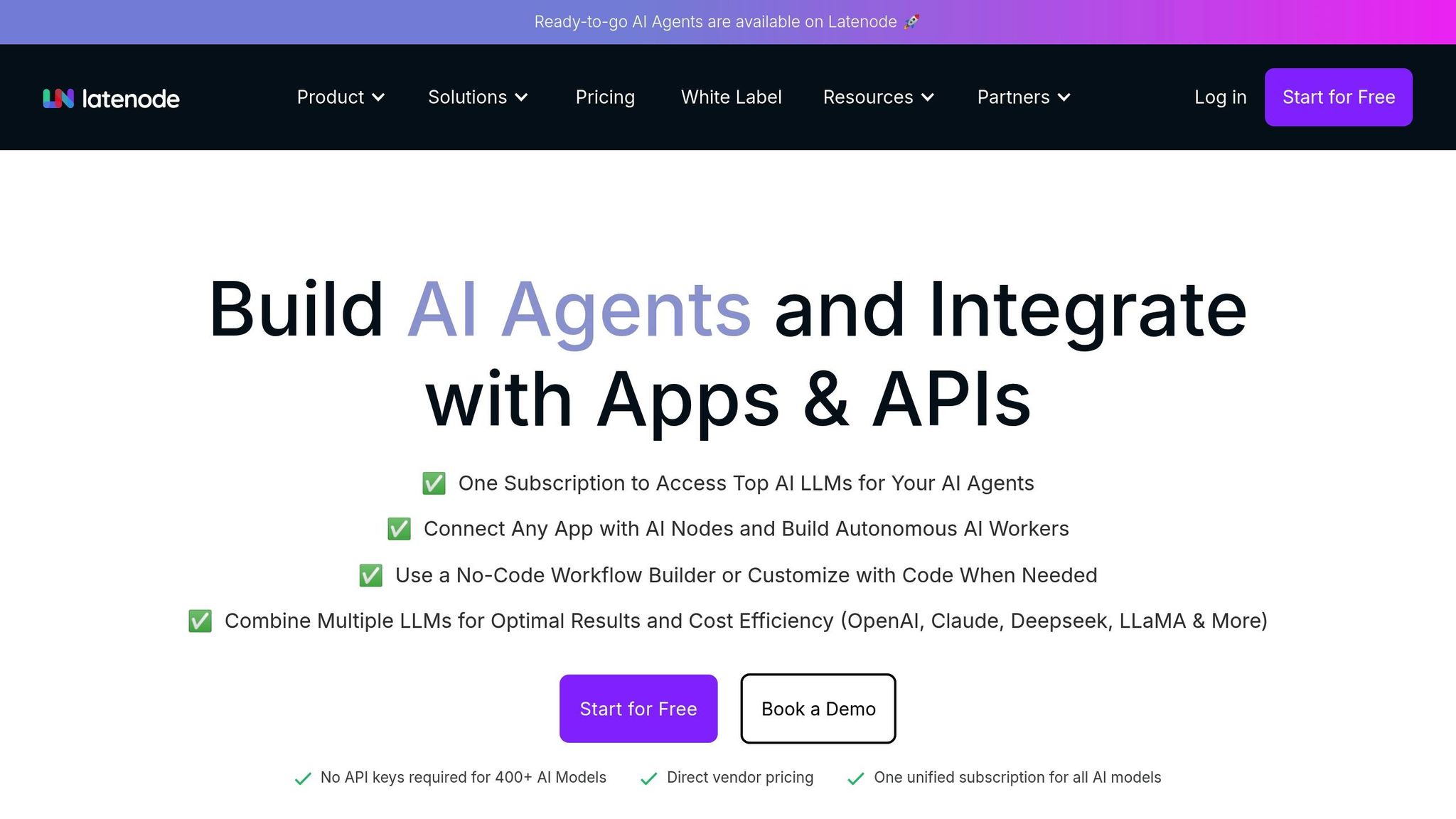


Agentic RAG is an advanced AI system that integrates autonomous decision-making with retrieval-augmented generation. Unlike static systems, it dynamically refines searches and responses, delivering precise, context-aware results. For example, in customer support, it can independently escalate issues, retrieve relevant data, and provide comprehensive solutions in a single interaction. Platforms like Latenode simplify implementing these workflows with visual tools, enabling teams to build and maintain intelligent systems without complex coding. This approach transforms tasks like document processing, knowledge support, and enterprise automation into efficient, adaptable processes.
Traditional RAG systems follow a straightforward retrieval process, while agentic RAG systems introduce autonomous decision-making to enhance flexibility and adaptability.
The distinction between standard and agentic RAG systems lies in how they approach information retrieval. Standard RAG systems rely on a linear workflow: they receive a query, retrieve relevant documents, and generate a response. While effective for straightforward queries, this static approach struggles with complex or multi-step questions. It cannot adjust its strategy mid-process or recognize when the initial retrieval misses critical context.
In contrast, agentic RAG systems incorporate autonomous agents capable of making real-time decisions. These systems evaluate the quality of initial results and can reformulate queries or initiate additional searches when necessary. This dynamic architecture introduces decision-making layers that assess context, analyze information quality, and adapt retrieval strategies accordingly.
Agentic systems also stand out for their ability to refine responses iteratively. Instead of relying solely on the first retrieval attempt, they continuously assess gaps in information and conduct additional retrieval cycles to enhance response accuracy and depth. This iterative process results in more comprehensive answers, especially for complex or nuanced queries.
| Feature | Standard RAG | Agentic RAG |
|---|---|---|
| Decision Making | Fixed, linear workflow | Adaptive, context-aware decisions |
| Retrieval Strategy | Single-pass retrieval | Multi-pass, adaptive retrieval |
| Query Handling | Direct query processing | Refines and reformulates queries |
| Error Correction | No self-correction | Iterative self-assessment |
| Learning Capability | Static patterns | Continuously adapts strategies |
| Response Quality | Relies on initial retrieval | Improves through iterative refinement |
| Complexity Handling | Limited to simple queries | Handles complex, multi-step questions |
| Resource Efficiency | Lower computational needs | Higher processing demands |
| Implementation | Simple setup | Requires agent orchestration |
| Maintenance | Manual optimization | Self-optimizing behavior |
These differences emphasize how agentic RAG systems bring a proactive and adaptable approach to information retrieval. For example, when dealing with multi-part questions or scenarios requiring domain-specific expertise, standard RAG systems often deliver incomplete answers based on their initial retrieval. Agentic systems, on the other hand, recognize such limitations and dynamically expand their search, cross-reference data, and synthesize more thorough responses.
This shift in architecture reflects a move toward more strategic and human-like information gathering, paving the way for a deeper exploration of how agentic RAG systems integrate into workflows and address real-world challenges.
Agentic RAG systems rely on an intricate architecture where various specialized components work in unison to enable autonomous information retrieval and response generation. Each component plays a distinct role, contributing to the system’s ability to process information dynamically and efficiently.
Several essential components form the backbone of agentic RAG systems, driving their ability to make decisions and process information flexibly:
These components come together to create a dynamic system capable of analyzing query complexity and orchestrating retrieval steps autonomously. The process begins with the router agent, which activates planning agents to devise strategies tailored to the query's requirements. These strategies consider factors like the scope of information needed and areas that may require deeper exploration.
Planning agents then coordinate with vector repositories to perform semantic searches across relevant knowledge bases, gathering documents and data points that match the query. Memory systems contribute by providing context from prior interactions, offering insights based on successful past retrievals. Simultaneously, evaluation modules assess the quality of retrieved content, ensuring the system refines its approach iteratively.
Throughout this workflow, LLMs play a pivotal role by refining queries, assisting in content evaluation, and synthesizing information into coherent responses that address the original inquiry. The memory system records key takeaways from each interaction, enabling the agentic RAG system to improve its decision-making and adapt to evolving challenges over time.
This harmonious integration of components creates a foundation for intelligent, autonomous workflows, a principle central to Latenode's innovative approach.
Agentic RAG workflows represent a major evolution in how information retrieval systems operate. Instead of relying on fixed, linear processes, these workflows employ autonomous agents to make decisions, break down complex queries, and manage multi-step tasks in real time. This dynamic approach bridges strategic planning with on-the-spot decision-making, creating a more agile and intelligent system.
At the heart of agentic RAG workflows is query decomposition. When faced with a complex request, the system intelligently divides it into smaller, more manageable tasks. Planning agents handle this breakdown, enabling the system to address intricate problems that traditional retrieval systems struggle to manage.
Next comes real-time tool selection, where agents choose the most suitable retrieval tools for each sub-task. Instead of sticking to a one-size-fits-all method, agents assess each task's unique requirements and select tools that deliver the best results.
The system's intelligence shines through its use of iterative reasoning. Agents refine queries, rerun searches, and perform multi-step reasoning to gather detailed and accurate information. If the initial results fall short, agents adjust their approach - fine-tuning search parameters or exploring alternative data sources. This adaptability makes it particularly effective for handling ambiguous or layered queries.
Feedback loops and persistent memory further enhance the system's capabilities. Evaluation modules identify areas for improvement when results are suboptimal, while memory systems maintain context across interactions. This allows agents to learn from past experiences, improving their responses over time and providing more personalized assistance.
According to recent research, agentic RAG systems can boost retrieval and response accuracy by up to 45% compared to traditional systems [2]. This improvement stems from their ability to refine processes, adapt to new information, and learn without requiring manual adjustments.
Agentic RAG workflows transform complex tasks into streamlined, automated processes, making them invaluable in various enterprise applications.
Smart document processing is one area where agentic RAG excels. In corporate settings, these systems handle unstructured data by analyzing document content and choosing the best tools for extraction. For example, agents might use OCR tools for scanned documents, natural language processing for text analysis, or specialized parsers for structured data. They can even cross-reference information across multiple documents, generating summaries that highlight key points and flag inconsistencies. The system adjusts its methods based on the complexity of the documents it processes.
Knowledge support systems demonstrate how agentic RAG provides contextual assistance in workplaces. These systems analyze employee queries, determine intent, and pull relevant information from internal databases. For example, when an employee asks a complex policy question or seeks help with technical troubleshooting, the system breaks the query into smaller components, retrieves data from the right sources, and compiles a comprehensive response. Over time, it learns from successful interactions, improving its ability to anticipate needs and deliver precise answers.
Enterprise automation workflows are another area where agentic RAG proves invaluable. Take customer onboarding as an example: agents can process applications, check compliance requirements, verify information against regulatory databases, and create personalized onboarding pathways. The system adapts its approach based on factors like customer type, location, and applicable regulations, ensuring every process is efficient and compliant.
Traditionally, building agentic RAG systems involves complex multi-agent architectures and intricate decision-making models. However, platforms like Latenode simplify this process. With its visual workflows, Latenode integrates agentic principles such as intelligent branching, conditional logic, and adaptive automation. This allows teams to implement agentic RAG systems more quickly and maintain them more easily compared to custom-built solutions.
Intelligence milestone: An Agentic RAG system autonomously improved its accuracy by 60% through iterative learning and adaptation [3].

Traditional agentic Retrieval-Augmented Generation (RAG) systems often demand intricate coding and technical expertise. Latenode simplifies this process by offering a visual platform that enables autonomous and intelligent workflows without the need for complex programming.
Latenode brings the principles of agentic RAG into a user-friendly environment through its visual workflow builder. Instead of relying on custom code, users can utilize drag-and-drop components to create workflows that demonstrate autonomous decision-making and adaptability.
One standout feature is its conditional logic blocks, which serve as the backbone for intelligent decision-making. These blocks allow workflows to analyze data, user inputs, or external signals at any stage, enabling dynamic adjustments. For instance, a workflow could evaluate whether retrieved data meets certain quality standards and then decide to re-query different sources, escalate the issue to a human, or follow an alternative processing path.
Intelligent branching further enhances adaptability by enabling workflows to assess the complexity of queries and direct them through context-sensitive paths. Imagine a customer support scenario: a workflow might start by retrieving basic information but, if the results are inadequate, it could automatically escalate to more advanced retrieval methods or external API calls.
With over 300 app integrations, Latenode connects workflows to a wide range of data sources and business tools. This allows workflows to dynamically choose the best retrieval paths based on real-time needs, whether accessing internal databases, external APIs, or specialized knowledge repositories.
Context-aware triggers play a key role in monitoring factors like data quality, user satisfaction, and system performance. These triggers enable workflows to adjust in real time, creating the feedback loops and persistent memory essential for autonomous systems.
Additionally, AI-native integration incorporates advanced language model capabilities directly into workflows. Teams can seamlessly integrate models like OpenAI, Claude, or Gemini, using structured prompts to generate sophisticated responses that adapt to the retrieved context and user requirements.
Latenode addresses the primary challenges of deploying agentic RAG systems, including technical complexity, lengthy development times, and high maintenance demands.
Simplified technical requirements eliminate the need for orchestrating multiple agents, managing intricate error handling, or writing extensive custom code. Latenode streamlines these processes with visual logic and reusable components, reducing the likelihood of errors and making troubleshooting and updates far more straightforward.
Research shows that low-code platforms can cut development time by up to 70%, reduce maintenance costs, and enable broader collaboration among business users and subject matter experts [1].
Faster implementation and broader accessibility empower teams to design, prototype, and deploy intelligent workflows in a fraction of the time it would take with traditional coding methods. What once required months of development can now be achieved in days or weeks. Moreover, business analysts, product managers, and domain experts can actively contribute to workflow design, removing the dependency on specialized technical skills.
Streamlined maintenance and updates are another major advantage. Latenode's visual editor provides a clear, graphical view of all decision points and data flows, making it easy to trace logic, audit processes, and identify inefficiencies. Updates can be made visually, allowing for quick iterations as requirements evolve.
Cost-effective scaling is facilitated by Latenode's usage-based pricing model, which charges based on actual execution rather than per task or user. This approach makes it affordable for organizations to experiment with and expand agentic RAG workflows as their value becomes evident.
Transparency and control are also central to Latenode's design. Every step, decision, and data transformation in a workflow is visually documented, simplifying analysis, compliance, and continuous improvement efforts. This clarity ensures that even sophisticated agentic behaviors remain understandable and manageable.
For teams looking to implement agentic RAG capabilities without the technical hurdles, Latenode provides a practical and efficient solution. Its visual platform delivers autonomous decision-making, contextual intelligence, and adaptive automation, making advanced agentic workflows accessible to users across various technical backgrounds. This approach not only simplifies deployment but also ensures long-term flexibility and ease of use.
Surveys suggest that by 2025, most AI teams will adopt agentic RAG as a core component of their workflows.
Developing agentic RAG workflows requires careful planning and a balance between technical complexity and practical application. The best way to begin is by focusing on clear, specific use cases and gradually building the system's capabilities.
Start by defining retrieval scenarios tailored to your business needs. Identify processes where autonomous decision-making can make a difference. For example, in customer support, agentic RAG can customize responses: simple queries might pull from an FAQ database, while more complex issues could trigger searches across documentation, support tickets, or expert knowledge bases.
Next, choose high-quality, structured data sources to support retrieval tasks effectively. Instead of overwhelming the system with every available data source, begin with 3–5 well-organized knowledge bases. This approach ensures the system can accurately determine which sources to query based on the context of the request.
Begin with simple conditional rules and expand to more complex logic over time. For instance, an initial workflow might use straightforward if-then rules: if a query mentions technical terms, search engineering documentation; if it involves billing, access financial systems. As your system matures, you can implement more advanced decision-making that evaluates multiple factors simultaneously.
Tools like Latenode simplify this process by offering a visual platform for building agentic RAG workflows. With Latenode, teams can prototype workflows using conditional logic blocks and branching paths without needing to write intricate orchestration code. A typical setup might start with an HTTP Request that triggers OpenAI GPT-4 model calls, logs results to Google Sheets, and branches into different retrieval paths based on query analysis.
To ensure success, monitor metrics like decision accuracy, retrieval relevance, and user satisfaction, and refine the system based on real-world performance. Latenode’s visual development tools make it easy to iterate and improve workflows over time.
Finally, scale incrementally by adding new data sources, decision-making layers, and autonomous capabilities as the system demonstrates reliability and effectiveness.
Once foundational workflows are established, emerging trends in the field can help you push the boundaries of autonomy and functionality.
Agentic RAG systems are evolving rapidly, driven by innovations in multimodal AI, enterprise requirements, and the growing need for autonomous knowledge management.
Multimodal retrieval capabilities are expected to be a game-changer. These systems will soon be able to decide whether to retrieve text, images, videos, or audio content based on the context of a query. Analysts predict that agentic RAG systems will increasingly support this kind of multimodal retrieval.
Continuous learning and adaptation will allow systems to refine their retrieval strategies automatically. By analyzing patterns of success and incorporating user feedback, these systems will become more effective over time with minimal manual intervention.
Enterprise-grade governance and compliance features are becoming essential. Businesses require systems that maintain audit trails, respect data access permissions, and comply with regulatory standards. Features like automatic redaction of sensitive information and intelligent routing based on user clearance levels are becoming standard.
Integration with business process automation is expanding beyond basic retrieval tasks. Advanced agentic RAG systems will soon trigger actions like updating CRM records, initiating approval workflows, or scheduling follow-up tasks - all without human input.
Cost optimization through smart resource management will also play a crucial role. These systems will balance computational costs with retrieval depth, using quick searches for routine queries and reserving intensive processing for more complex requests.
Visual platforms like Latenode are democratizing the development of agentic RAG systems, making these advanced capabilities accessible to a wider range of teams. By building on these emerging trends, agentic RAG is set to become indispensable for enterprises. These systems will handle complex decisions autonomously, managing the retrieval, processing, and application of critical information across diverse business environments.
Agentic RAG takes retrieval-augmented generation to the next level by incorporating autonomous decision-making into its processes. Instead of sticking to static retrieval methods, it adjusts its strategies in real time, responding to the unique context and flow of each interaction. This flexibility allows it to determine not only what information to retrieve but also how to process it, resulting in outcomes that are more precise and tailored to the situation.
This adaptability has proven to make a measurable difference, with research showing up to a 45% boost in response accuracy. By staying context-aware and refining its actions dynamically, Agentic RAG provides smarter and more dependable results that align closely with the specific demands of every interaction.
In an Agentic RAG system, two key components - router agents and planning agents - work together to create intelligent and autonomous workflows.
By combining these elements, the system can operate autonomously, making informed decisions and responding effectively to changing conditions - an essential feature of advanced retrieval-augmented generation systems.
Latenode streamlines the creation of Agentic RAG systems by providing a visual workflow platform equipped with tools like intelligent branching, conditional logic, and adaptive automation. This eliminates the complexity of traditional programming and multi-agent setups, making these advanced systems approachable even for teams without deep technical skills.
Through Latenode's no-code interface, businesses can design AI systems that autonomously adapt, make decisions, and process information in a smart and efficient way. This means companies can take full advantage of Agentic RAG capabilities - such as enhanced accuracy and flexible decision-making - without needing to overcome the usual technical barriers.



